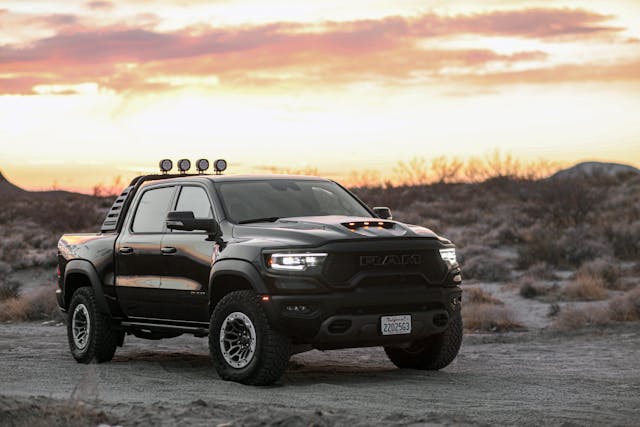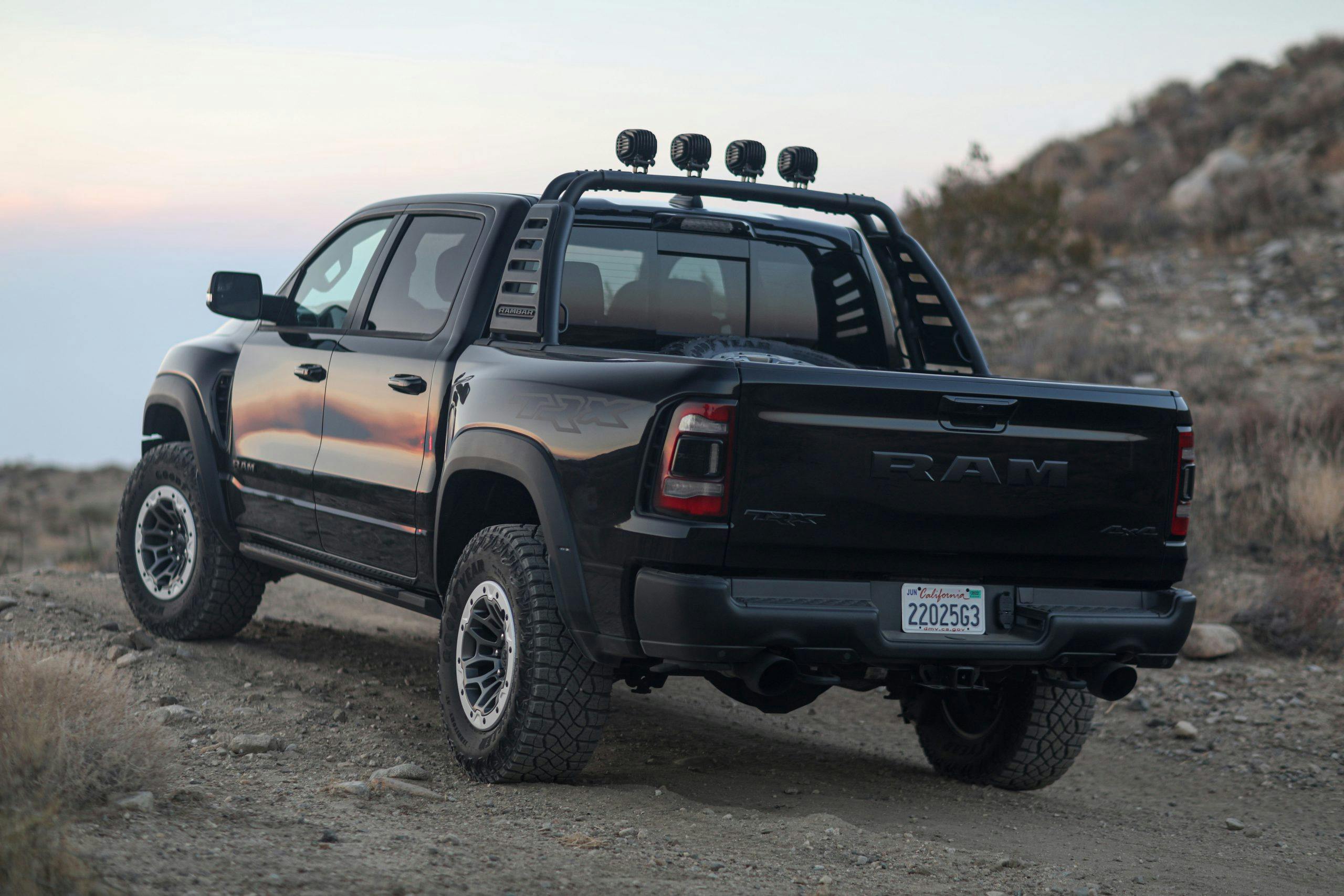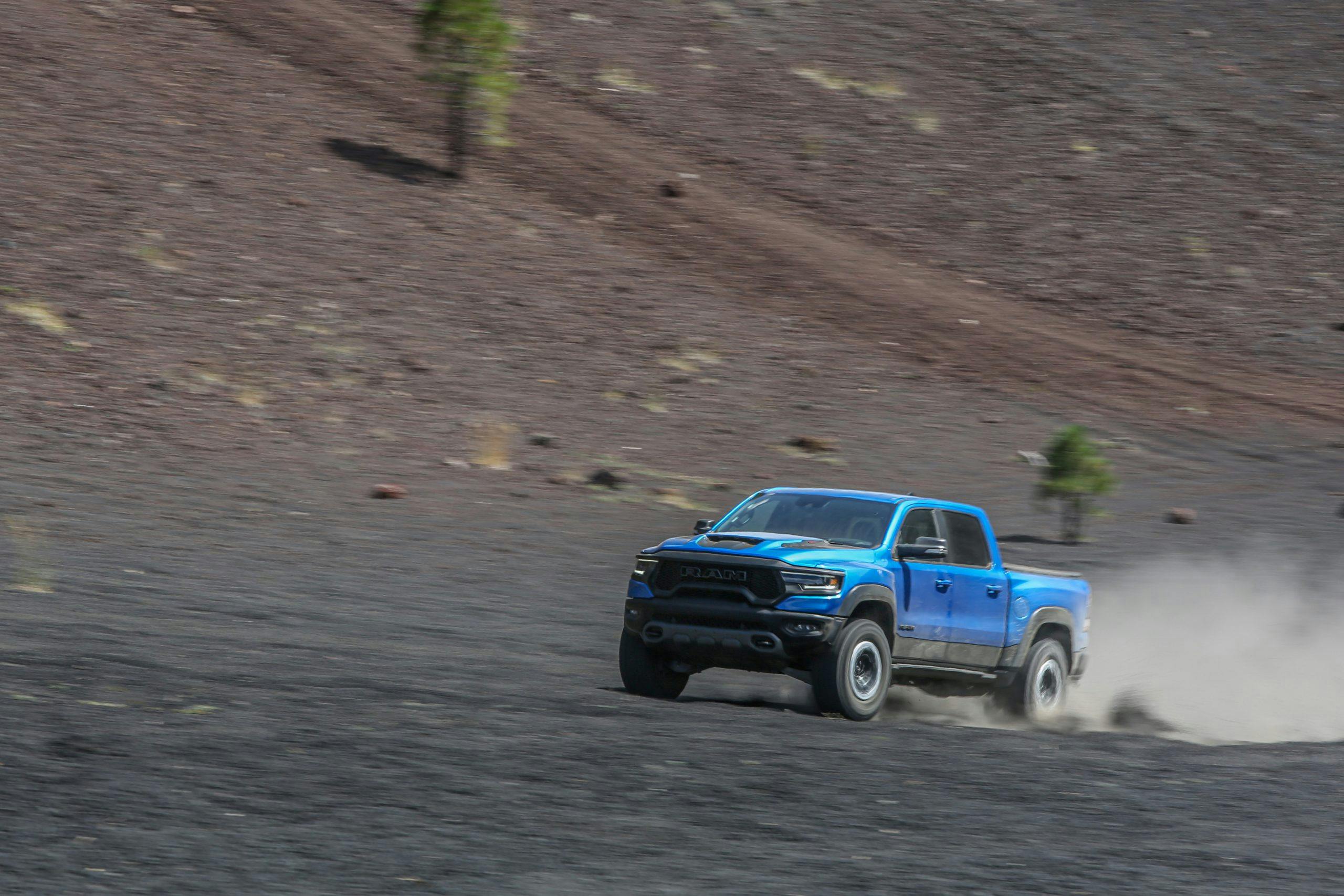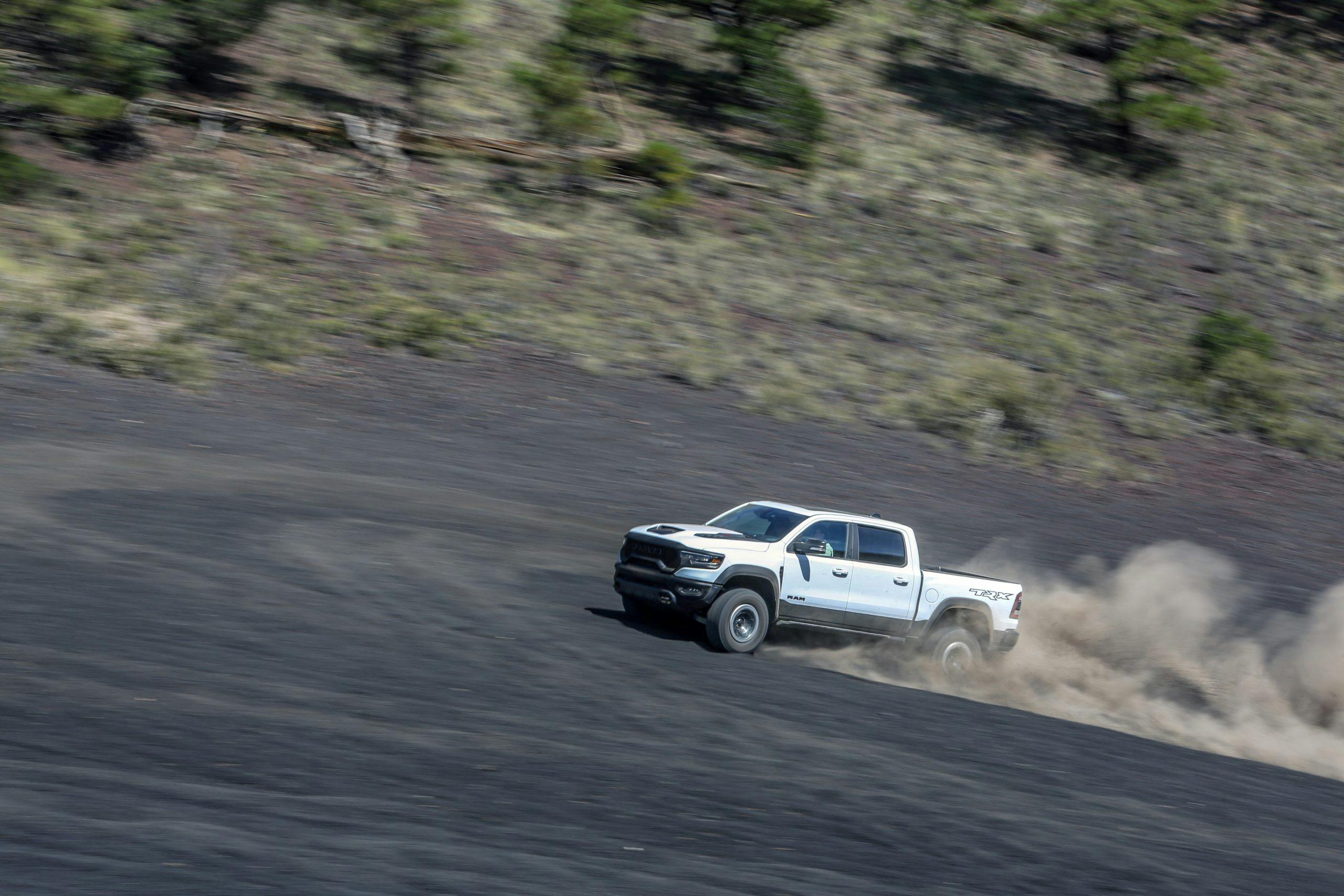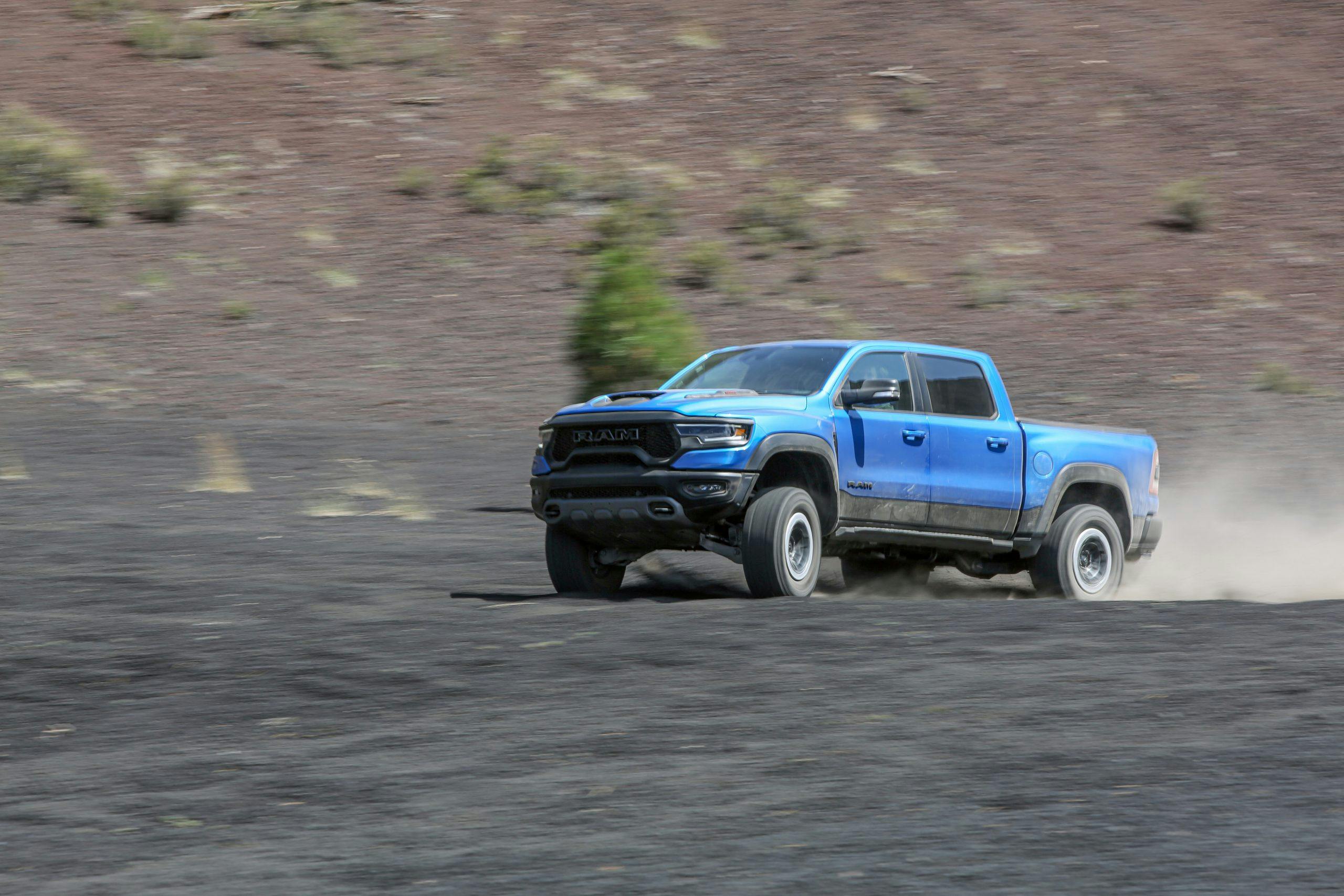TRX vs. Power Wagon: Trial of the Ram 4×4 trucks
Pickup trucks are a huge business in North America, and the major players in the full-size segment have been busy one-upping each other for decades. The current crop of both light-duty and heavy-duty full-sizers serves up more towing and hauling than ever. Meanwhile, their interiors are decked out with the kinds of materials and infotainment systems you’d expect to find in a decent luxury car. The reason so many Americans love their trucks is that they are the most versatile, durable machines on the road.
One fascinating niche of this truck war has been the surge of off-road capability from half-tons that come straight from the factory. That trend was really kicked off with the introduction of the Ford SVT Raptor. Chevrolet is finally priming a Silverado ZR2 to follow the excellent Colorado ZR2 and get into the full-size desert-runner game, and Ram’s first salvo was a mighty one: the 2021 TRX that takes aim squarely at Ford’s Raptor.

We’ve published a first-drive review of the TRX before, but we’ve never driven one back-to-back with the father of all 4×4 pickups, the Ram Power Wagon. The Power Wagon first went on sale in 1946 and was the first 4×4 pickup consumers could buy straight off the assembly line. Ram is celebrating that heritage with a 75th Anniversary Edition that packs nearly every tough off-roader option imaginable into a compelling package of style and luxury. It’s about as comfortable as you can get while still hauling around two solid axles.

Even though these two trucks aren’t direct competitors, we couldn’t help but pit them against one another, when given the opportunity at a recent Ram off-roading event in Arizona. The Power Wagon is a more hardcore off-roader than a GMC Sierra AT4, although Ford’s Tremor package for the Super Duty is a good match. The Ram uses a 410-hp, 6.4-liter Hemi paired with an eight-speed auto. The wild TRX, meanwhile, will take on the upcoming Silverado ZR2 and the existing Ford Raptor, bringing with it a whole lot more power than either of those rivals. It’s powered by a truck version of the supercharged, 6.2-liter Hellcat V-8 that makes the Challenger and Charger so much fun to drive. Breathing through a huge hood scoop and a massive air filter system, the engine churns out 702 hp and, like its Hellcat brethren, has torque all over the rev range. It rides on tires that are nearly 35 inches tall and uses a unique suspension to deliver 14 inches of front-wheel travel.

Even on the highway, the differences between these trucks are apparent. The TRX is totally composed on the highway and completely unbothered by gusting crosswinds. Surprisingly, there’s very little noise from the off-road tires and even when cruising along with traffic at almost 80 miles an hour there is not much in the way of wind noise. Even the supercharged 6.2-liter V-8’s exhaust emits more of a murmur than a growl at 1800 rpm. It’s only when you nudge the throttle open that the supercharger whine cues the exhaust to come alive. Of course, you’ll be reminded of that massive V-8 under the hood each time you stop to fill up. We averaged 12.5 mpg in the TRX, even though most of our travel was highway cruising from L.A. to Arizona.
The Power Wagon, also exceptionally quiet over a smooth highway, transfers more of the road surface into the driver seat through its solid front axle and heavy-duty springs. It is a 3/4-ton truck after all. Still, it isn’t a terrible place to spend a road trip. Unfortunately, because most of our short time behind the wheel of the Power Wagon was spent slogging up rutted trails, we don’t have any relevant fuel economy numbers. Considering its bulk, however, we wouldn’t expect it to do much better than the TRX.
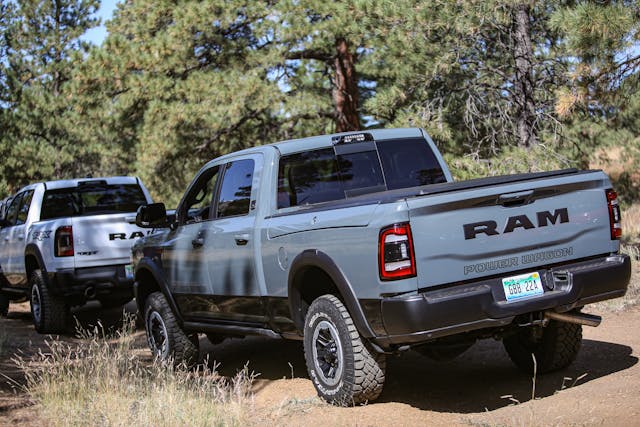
The off-road portion of our Power Wagon test had us tromping around with about half of the air pressure let out of the tires, which absolutely transformed the Power Wagon’s ride quality. All of the irregularities in the pavement that had been translated into jolts and jostles were smoothed over. Naturally, the speeds are reduced when the tire pressures go down, so that helps, but when the tire’s sidewalls actually get to become a contributing member of the suspension team, things become a bit more pleasant inside the Power Wagon.
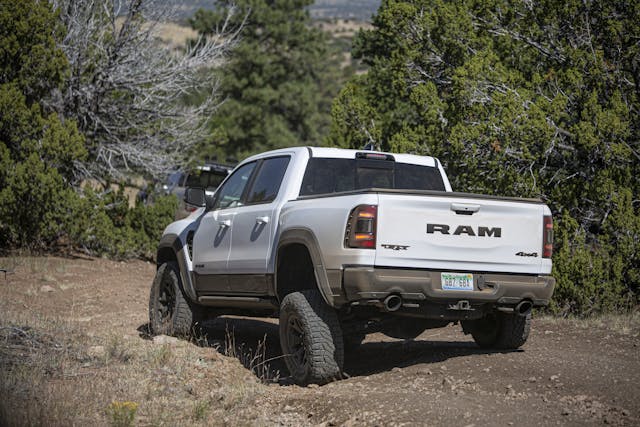
Climbing the same rutted, cinder gravel hills in both the Power Wagon and the TRX reveals the stark difference in their suspension designs. The TRX, with its independent front suspension and lighter rear springs, virtually floats over the surface compared to the Power Wagon, which bucks and bangs over the terrain and rattles its occupants with a staccato shake. The Power Wagon will conquer much of the same challenges you could throw at a TRX and be unfazed. The muscle and bones seat-belted inside, on the other hand, may have some objections.
We did use the TRX briefly off-road on some sandstone trails without airing down, and the low-speed ride was somewhat comparable to the aired-down Power Wagon. The compliant suspension makes quick jaunts off-road at normal tire pressures easy, although, like the Power Wagon, you can get some shoulder tossing if you get a bit too aggressive over whoops. When we did air down to about 25 psi, the ride improved measurably. Rutted terrain that would have us bucking up and down at 10 mph was easily sailed over at 35 mph, the tires and suspension quickly oscillating to soak up the uneven ground.
One of the most impressive tests of the TRX’s off-road prowess was driving into and out of a steep cinder cone. The cone-shaped bowl, remnants of an extinct Pleistocene volcano, is 900 feet tall and covered in pea-sized cinder gravel. We parked the Power Wagon for this bit of hooning and used only a pair of TRXs to make laps down into the bottom of the crater and part-way up the opposite side before powering back up the crater to reach the rim again. Standing at the top of the crater makes the sides look every bit as steep as they are, but the power and suspension travel of the TRXs allowed them to scramble up with ease. Would the Power Wagons have been able to do the same? Perhaps, but it would likely have taken a lot more skill and it would have also been quite a rough ride.
For those that want to go fast, the TRX is the easy pick for Baja-style desert fun, but they are pricey. With any luck, Ram will see fit to drop a 392 under the hood to get that amazing suspension in a more affordable package and go for some extra volume. The Power Wagon’s real advantage is its work-truck capability, not to mention its considerably more affordable entry price, but it’s hard to deny the TRX’s supreme performance and comfort. We’ve gotta hand this round to the TRX. Chugga-chugga is nice, but VROOM is spectacular!
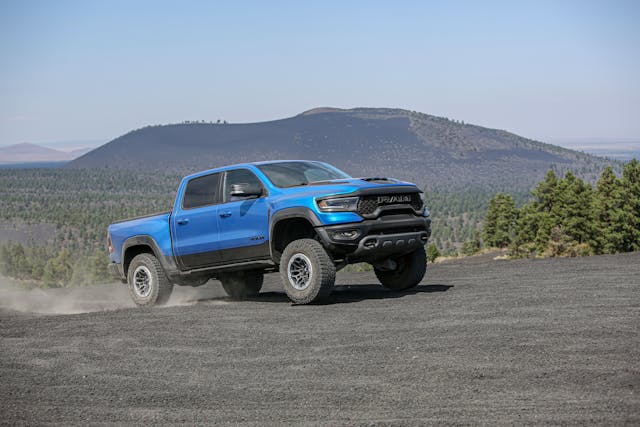
2021 Ram TRX
Highs: Fantastic looks, amazing suspension, gonzo powertrain.
Lows: Horrendous fuel economy, high entry price.
Base Price/As-Tested: $72,120/$96,120
2021 Ram Power Wagon
Highs: Powerful gas engine, excellent off-road hardware, impressively outfitted interior.
Lows: Not available with the Cummins. Still rides like the HD truck it is.
Base Price/As-Tested: $56,735/$71,185
Summary: The TRX’s titanic performance is simply addicting, and most truck buyers with off-road ambitions will be satisfied with a half-ton. But those that truly need a work truck to haul, or want a sturdy overlander that can also accommodate a slide-in camper, will have no regrets opting for the Power Wagon.
